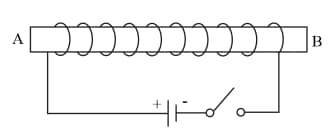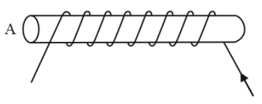Magnetic Effect of Current (or Electromagnetism)
Magnetic Effect of Current (or Electromagnetism): Overview
This topic describes electromagnetism. An experiment is given to demonstrate the magnetic effect of current. We will study the magnetic field patterns produced by a straight, circular loop and a solenoid carrying current.
Important Questions on Magnetic Effect of Current (or Electromagnetism)
Write some of the important uses of electromagnets.
State the factors on which the strength of an electromagnet depends. How does it depend on these factors?
Explain why the core of an electromagnet should be of soft iron and not of steel.
Explain why an electromagnet is called a temporary magnet.
What type of core should be put inside a current-carrying solenoid to make an electromagnet?
What is the shape of field lines inside a current-carrying solenoid? What does the pattern of field lines inside a current-carrying solenoid indicate?
Name the type of magnet with which the magnetic field pattern of a current-carrying solenoid resembles.
What is a solenoid? Draw a sketch to show the magnetic field pattern produced by a current-carrying solenoid.
How does an electromagnet differ from a permanent magnet?
(a) Draw a circuit diagram to show how a soft iron piece can be transformed into an electromagnet.
(b) Describe how an electromagnet could be used to separate copper from iron in a scrap yard.
The directions of current flowing in the coil of an electromagnet at its two ends and are as shown below:

What is the polarity of end ? (South pole / North pole)
A current flows downwards in a wire that passes vertically through a table top. Will the magnetic field lines around it go clockwise or anticlockwise when viewed from above the table?
For the coil in the diagram below, when the switch is pressed, what is the polarity of end A? (North Pole, South Pole)

The figure shows a solenoid wound on a core of soft iron. Will the end A be a N pole or S pole when the current flows in the direction shown?

In the straight wire , a current is flowing in the vertically downward direction whereas in wire , the current is flowing in the vertically upward direction. What is the direction of the magnetic field in wire ?
(Choose from the following: Clockwise/ Anti-clockwise)
The magnetic effect of current was discovered by:
A thick wire is hanging from a wooden table. An anticlockwise magnetic field is to be produced around the wire by passing current through this wire by using a battery. Which terminal of the battery should be connected to the:
(a) top end of wire?
(b) bottom end of wire?
Give reason for your choice.
A current-carrying conductor is held in exactly vertical direction. In order to produce a clockwise magnetic field around the conductor, the current should be passed in the conductor:
The magnetic field associated with a current-carrying straight conductor is in anticlockwise direction. If the conductor was held along the east-west direction, what will be the direction of current through it? Name and state the rule applied to determine the direction of current?
The directions of current flowing in the coil of an electromagnet at its two ends and are as shown below:

Name and state the rule which you have used to determine the polarities.
